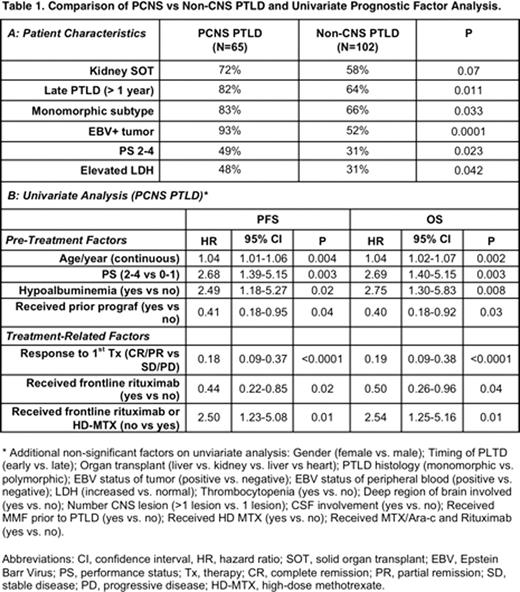Abstract
Abstract 879
Several solid organ transplant (SOT) PTLD series have reported that PCNS disease is a poor prognostic factor (e.g., Leblond et al, JCO 2001; Maeker et al, JCO 2007; Knight et al JCO 2009; Evens et al, JCO 2010). However, these reports contained small PCNS PTLD numbers and most series studied patients (pts) in the pre-rituximab era.
We performed an International retrospective analysis of PCNS SOT-related PTLD diagnosed from 1998 through 2010. Cases with secondary CNS localization were excluded. Detailed pt and disease characteristics, including frontline therapy, were evaluated. Fisher's exact test was used to compare PCNS PTLD vs non-PCNS PTLD cases. Further, univariate associations with survival were determined, while a multivariate Cox regression proportional hazards model was performed.
71 PCNS PTLD cases were identified, of which 65 had complete data. There were 35 men and 30 women; the median age was 53 years (range, 20–77 years). The most common type of SOT was kidney in 72%, followed by lung 18% and 5% each pancreas and heart. The median time from SOT to PCNS PTLD was 46 months (range, 2 to 504 months). Further, only 18% occurred within 12 months of SOT, and 32% of PTLD diagnoses occurred > 10 years after SOT. 85% of pts had received prior mycophenolate, while 30% received tacrolimus prior to PCNS PTLD. According to WHO histology, 83% of PCNS PTLD cases were monomorphic subtype (all B-cell), while tumor was EBV+ in 93% despite EBV being detectable in the peripheral blood (by PCR) in only 38% of these cases. In addition, 49% of pts had poor performance status (i.e., 2–4), 48% had elevated LDH, and 48% were hypoalbuminemic at diagnosis. Interestingly, several of these characteristics were notably different when compared with a non-PCNS PTLD cohort (Table 1A). All pts here presented with CNS-related symptoms and 98% had abnormal findings on MRI showing a parenchymal brain lesion(s); 50% of pts had >1 CNS lesion and 40% had involvement of deep regions of the brain. Further, 12% had concomitant CSF involvement, while no pts had ocular involvement. In terms of therapy, 89% of pts had reduction in immunosuppression (RI). Additional frontline therapy consisted of high dose methotrexate (HD-MTX)-based therapy in 43% (46% of whom also received concurrent rituximab), whole-brain radiation in 20% (61% with rituxmab), high-dose cytarabine (HDAC)-based in 15% (30% with rituximab), while 11% received rituximab alone and 11% had no other therapy (i.e., RI alone). Altogether, 48% of pts received rituximab as part of initial therapy. The overall response rate (ORR) was 55% with 30% complete remission (CR) rate. With a median follow-up of 39 months (1–135), the 3-year progression-free survival (PFS) and overall survival (OS) for all pts were 31% and 32%, respectively (Figure 1). Pts who received rituximab vs not as a component of first line therapy had superior PFS (40% vs 22%, respectively, p=0.02) and borderline improved OS (43% vs 22%, respectively, p=0.06), while pts who did not receive rituximab nor HD-MTX-based therapy as frontline therapy did particularly poor (PFS and OS both 10%). Several pre-treatment and treatment-related factors predicted survival on univariate analysis (Table 1B). When analyzing only pre-treatment related factors in the Cox multivariate regression model, only increasing age remained significant (PFS: HR 1.04 [95%CI 1.00–1.07], p=0.031; and OS: HR 1.04 [95%CI 1.01–1.08], p=0.020). With treatment-related factors included in the model, response to frontline therapy (CR or partial remission) was the dominant predictive factor of survival on multivariate analysis (PFS: HR 0.136 [95%CI 0.047–0.390], p=0.0002; and OS: HR 0.130 [95%CI 0.045–0.381], p=0.0002).
These data represent the largest report of PCNS PTLD to date. PCNS PTLD appears to represent a distinct biologic and clinical entity within the PTLD spectrum that retains EBV positivity, occurs late, and presents with additional high-risk features. Furthermore, outcome of PCNS PTLD remains overall modest. However, these data suggest that rituximab and HD-MTX appear to favorably impact survival. Continued study of this subset of pts is critically needed.
No relevant conflicts of interest to declare.
Author notes
Asterisk with author names denotes non-ASH members.


This feature is available to Subscribers Only
Sign In or Create an Account Close Modal